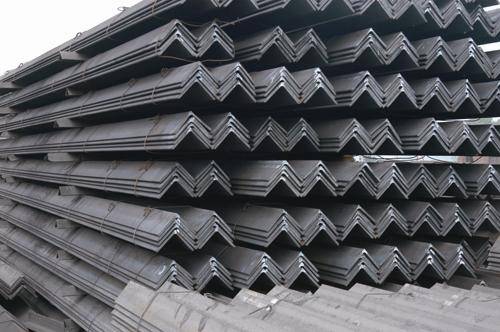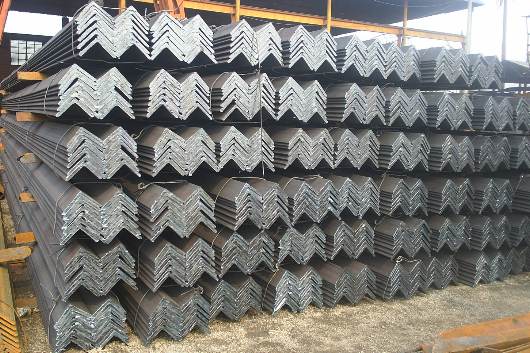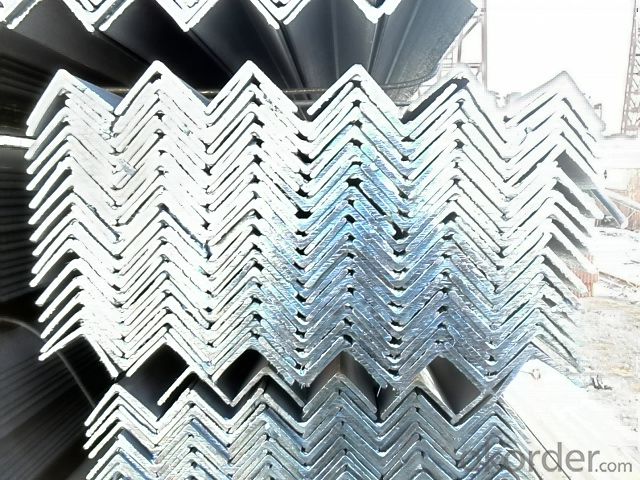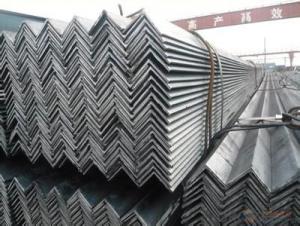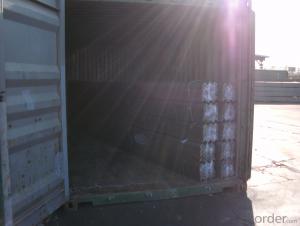Hot Rolled Equal Angle Steel with Grade GB-Q235
- Loading Port:
- Tianjin
- Payment Terms:
- TT OR LC
- Min Order Qty:
- 25 m.t.
- Supply Capability:
- 10000 m.t./month
OKorder Service Pledge
OKorder Financial Service
You Might Also Like
Product Description:
OKorder is offering high quality Hot Rolled Equal Angle Steel at great prices with worldwide shipping. Our supplier is a world-class manufacturer of steel, with our products utilized the world over. OKorder annually supplies products to European, North American and Asian markets. We provide quotations within 24 hours of receiving an inquiry and guarantee competitive prices.
Product Applications:
Hot Rolled Equal Angle Steels are ideal for structural applications and are widely used in the construction of buildings and bridges, and the manufacturing, petrochemical, and transportation industries.
Product Advantages:
OKorder's Hot Rolled Equal Angle Steels are durable, strong, and resist corrosion.
Main Product Features:
· Premium quality
· Prompt delivery & seaworthy packing (30 days after receiving deposit)
· Corrosion resistance
· Can be recycled and reused
· Mill test certification
· Professional Service
· Competitive pricing
Product Specifications:
Manufacture: Hot rolled
Grade: Q195 – 235
Certificates: ISO, SGS, BV, CIQ
Length: 6m – 12m, as per customer request
Packaging: Export packing, nude packing, bundled
EQUAL ANGLES SIZES |
| ||
a(mm) | a1(mm) | thickness(mm) | length |
25 | 25 | 2.5---3.0 | 6M/12M |
30 | 30 | 2.5---4.0 | 6M/12M |
38 | 38 | 2.5 | 6M/12M |
38 | 38 | 3.0---5.0 | 6M/12M |
40 | 40 | 3.0---6.0 | 6M/12M |
50 | 50 | 3 | 6M/12M |
50 | 50 | 3.7---6.0 | 6M/9M/12M |
60 | 60 | 5.0---6.0 | 6M/9M/12M |
63 | 63 | 6.0---8.0 | 6M/9M/12M |
65 | 65 | 5.0---8.0 | 6M/9M/12M |
70 | 70 | 6.0---7.0 | 6M/9M/12M |
75 | 75 | 5.0---10.0 | 6M/9M/12M |
80 | 80 | 6.0---10.0 | 6M/9M/12M |
90 | 90 | 6.0---10.0 | 6M/9M/12M |
100 | 100 | 6.0---12.0 | 6M/9M/12M |
120 | 120 | 8.0-12.0 | 6M/9M/12M |
125 | 125 | 8.0---12.0 | 6M/9M/12M |
130 | 130 | 9.0-12.0 | 6M/9M/12M |
140 | 140 | 10.0-16.0 | 6M/9M/12M |
150 | 150 | 10---15 | 6M/9M/12M |
160 | 160 | 10---16 | 6M/9M/12M |
180 | 180 | 12---18 | 6M/9M/12M |
200 | 200 | 14---20 | 6M/9M/12M |
FAQ:
Q1: Why buy Materials & Equipment from OKorder.com?
A1: All products offered byOKorder.com are carefully selected from China's most reliable manufacturing enterprises. Through its ISO certifications, OKorder.com adheres to the highest standards and a commitment to supply chain safety and customer satisfaction.
Q2: What makes stainless steel stainless?
A2: Stainless steel must contain at least 10.5 % chromium. It is this element that reacts with the oxygen in the air to form a complex chrome-oxide surface layer that is invisible but strong enough to prevent further oxygen from "staining" (rusting) the surface. Higher levels of chromium and the addition of other alloying elements such as nickel and molybdenum enhance this surface layer and improve the corrosion resistance of the stainless material.
Q3: Can stainless steel rust?
A3: Stainless does not "rust" as you think of regular steel rusting with a red oxide on the surface that flakes off. If you see red rust it is probably due to some iron particles that have contaminated the surface of the stainless steel and it is these iron particles that are rusting. Look at the source of the rusting and see if you can remove it from the surface.
Images:
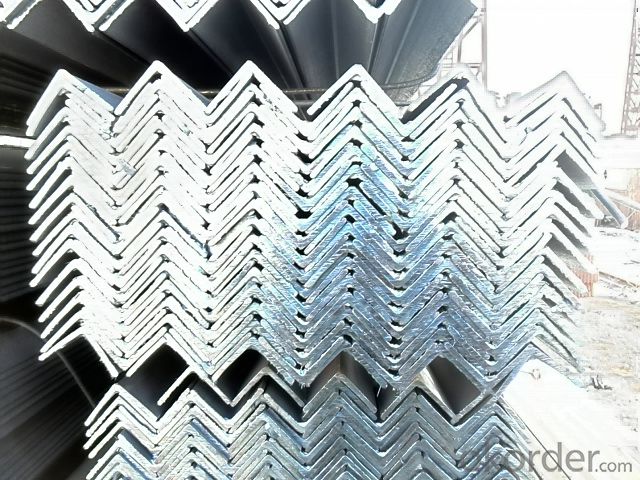
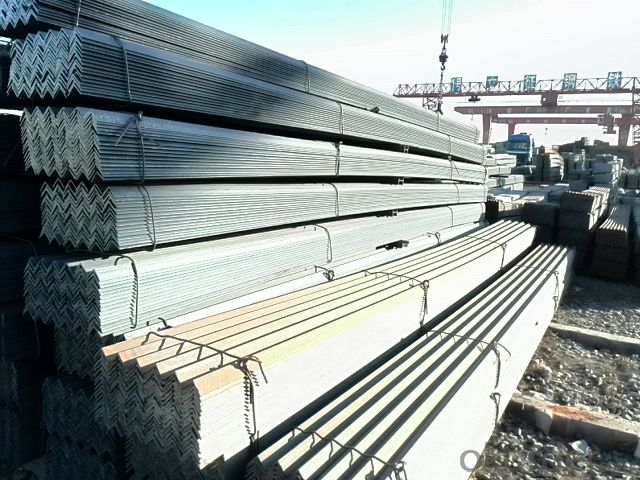
- Q: Can steel angles be used in signage?
- Yes, steel angles can be used in signage. Steel angles are versatile and durable structural components that can be easily fabricated and installed in various applications, including signage. They provide excellent strength and stability, making them suitable for supporting heavy or large signs. Additionally, steel angles can be welded, bolted, or riveted together, allowing for flexibility in design and customization. They can be painted or coated to enhance their appearance and protect against corrosion, ensuring the longevity of the signage. Overall, steel angles offer a reliable and robust solution for signage installations.
- Q: Can steel angles be used as reinforcements in concrete structures?
- Yes, steel angles can be used as reinforcements in concrete structures. Steel angles are commonly used to provide additional strength and support to concrete elements, such as beams, columns, and slabs. They are placed within the concrete to enhance its load-bearing capacity, improve structural integrity, and prevent cracking or failure. The versatility and durability of steel angles make them suitable for reinforcing various types of concrete structures.
- Q: What is the maximum length of a continuous steel angle?
- The maximum length of a continuous steel angle typically depends on various factors such as the manufacturing process, transportation limitations, and structural requirements. However, in general, the maximum length of a continuous steel angle can range anywhere from a few meters to several tens of meters.
- Q: What are the maximum allowable deflections for steel angles?
- The maximum allowable deflections for steel angles depend on various factors such as the specific application, loadings, and design codes or standards being followed. However, in general, deflections for steel angles should be within acceptable limits to ensure structural integrity and safety. It is recommended to consult relevant design codes, standards, or structural engineers to determine the specific maximum allowable deflections for steel angles in a given situation.
- Q: What are the common connection methods for steel angles?
- There are several common connection methods for steel angles, depending on the specific application and structural requirements. One of the most commonly used connection methods is welding. Steel angles can be welded together using various welding techniques such as arc welding or MIG welding. Welding provides a strong and durable connection, ensuring the angles remain securely joined. Another common method is bolting. Steel angles can be connected using bolts, nuts, and washers. This method allows for easy disassembly and reassembly if needed. Bolting is often preferred in situations where the angles may need to be adjusted or replaced in the future. Riveting is another connection method used for steel angles. This involves using rivets to connect the angles together. Riveting provides a strong and reliable connection, especially in applications where the angles are subjected to shear or tension forces. In some cases, steel angles can also be connected using adhesive bonding. This method involves using specialized adhesives to create a strong bond between the angles. Adhesive bonding is useful when welding or bolting is not feasible or desired. It is important to consider factors such as load capacity, structural integrity, and the specific requirements of the project when selecting the appropriate connection method for steel angles. Consulting with a structural engineer or professional in the field is recommended to ensure the best connection method is chosen for a particular application.
- Q: How do steel angles perform under wind loads?
- Steel angles are commonly used in construction for their strength and stability. When subjected to wind loads, steel angles perform exceptionally well due to their rigidity and ability to distribute the forces evenly. The shape of the angle, with its two legs forming a right angle, helps to resist bending and twisting caused by wind pressure. Overall, steel angles provide reliable support and structural integrity even in high wind conditions.
- Q: What are the different grades of steel angles?
- There exists a variety of steel angle grades, each possessing its own distinct properties and characteristics. Among the most frequently utilized grades are A36, A572, and A588. The grade known as A36 steel angle is the most commonly employed due to its exceptional strength and versatility. Possessing a minimum yield strength of 36,000 psi, it is suitable for a wide array of applications. A36 steel angle is frequently employed in construction projects and serves as structural support in buildings and bridges. Another extensively utilized grade is A572 steel angle, renowned for its superior strength and durability. With a minimum yield strength of 50,000 psi, it is ideal for heavy-duty applications. A572 steel angle is frequently employed in construction projects necessitating high strength, such as the erection of skyscrapers and large buildings. A588 steel angle, on the other hand, is a corrosion-resistant grade often employed in outdoor and marine environments. Engineered to withstand exposure to harsh weather conditions and corrosive elements, it possesses a minimum yield strength of 50,000 psi. A588 steel angle is commonly applied in coastal regions and in the construction of bridges and other structures exposed to saltwater or high humidity. These are merely a few examples of the diverse assortment of steel angle grades available. The selection of a grade hinges upon the specific application and the desired properties, including strength, corrosion resistance, and durability. It is essential to consult a professional or adhere to industry standards when choosing the appropriate grade of steel angle for a particular project.
- Q: Can steel angles be used in curtain wall systems?
- Yes, steel angles can be used in curtain wall systems. Steel angles are commonly used as support brackets or mullions in curtain wall systems. They provide structural strength and support to the glass panels or other cladding materials. Steel angles can be fabricated in various sizes and shapes to accommodate the specific design requirements of the curtain wall system. Additionally, steel angles can be welded or bolted together to create the desired framework for the curtain wall. Overall, steel angles offer a durable and reliable option for incorporating into curtain wall systems.
- Q: How do you calculate the weight-bearing capacity of a steel angle?
- To calculate the weight-bearing capacity of a steel angle, you need to consider its dimensions, material properties, and loading conditions. The weight-bearing capacity can be calculated using engineering formulas and techniques such as the Euler formula or the AISC Manual. These calculations take into account factors like the cross-sectional area, moment of inertia, and the applied loads to determine the maximum load the steel angle can support without failure.
- Q: Can steel angles be used in bridges?
- Yes, steel angles can be used in bridges. Steel angles are often used as structural elements in bridge construction due to their strength, versatility, and ability to provide support and stability. They can be used in various bridge components such as beams, trusses, and connections, helping to distribute loads and resist forces in bridge structures.
Send your message to us
Hot Rolled Equal Angle Steel with Grade GB-Q235
- Loading Port:
- Tianjin
- Payment Terms:
- TT OR LC
- Min Order Qty:
- 25 m.t.
- Supply Capability:
- 10000 m.t./month
OKorder Service Pledge
OKorder Financial Service
Similar products
Hot products
Hot Searches
Related keywords



